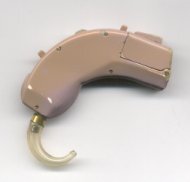
Nicolet Project Phoenix
Historical Perspective on Digital Hearing Aids:
The Nicolet Phoenix
The Project
Project Phoenix was a $20 million joint venture founded in 1984 between the University of Wisconsin and Nicolet Instrument Corporation to research and develop a programmable digital hearing aid and an advanced computer-based hearing test instrument(1). It was initially funded by the Wisconsin Alumni Research Foundation and the Wisconsin State Department and launched in 1984 under the direction of Kurt Hecox, MD, PhD(1).
Dr. Hecox founded Project Phoenix on the beliefs that there are individual differences in hearing loss characteristics, and that digital signal processing provided unique ways to manipulate sound that were simply not possible in an analog device. Concurrent development of the Aurora, audiodiagnostic workstation, and the Nicolet Phoenix, digital hearing aid, was driven by the belief that the development of a valid and reliable hearing aid fitting method for this new technology was just as important as the development of the digital hearing aid.
Academic researchers in hearing and speech science, psychoacoustics, neuroscience, and engineering, among others, were brought together with the research, design and manufacturing talents of a world-class manufacturer of biomedical instrumentation, Nicolet Instrument Corporation, to bring both products to market. Computer technology provided a flexible platform from which to implement rapid changes in hearing testing, hearing aid fitting protocols, and in the sound processing in the Aurora and Nicolet Phoenix(2).
Hearing Aid Fitting: The Aurora
Nicolet Aurora
The hearing aid fitting was performed using the Aurora. The Aurora was an 80286 computer-based audiodiagnostic workstation that was designed to test, evaluate, and fit hearing impairment. The Aurora had eight modules: Audiometer, Real Ear(3), Hearing Aid Analysis, Hearing Aid Fitting, PC mode and Database. An optional Middle Ear analyzer was also available. Although hundreds of new tests were possible to implement, priority was given to the development of the Hearing Aid Fitting module so that it would be ready for the launch of the digital hearing aid.
The Aurora Hearing Aid Fitting module simulated what users would experience when they wore the Nicolet Phoenix. The hearing aid earpieces (regular and power models) and digital signal processors in the Aurora and Nicolet Phoenix were identical to insure that the sounds heard during the fitting were identical to those the patient would experience while wearing the Nicolet Phoenix. Researchers at City University of New York and Nicolet felt that a paired-comparison method would allow patients to reliably converge on their preferences. A Modified Simplex procedure initially was used to find patient preferences for frequency shaping and noise reduction. Later, the Sliding Scale approach was implemented into the Hearing Aid Fitting module. The Hearing Aid Fitting module could also be used to fit conventional hearing aids as well as the Nicolet Phoenix
Ongoing research in the laboratory and with portable field units, evaluated digital signal processing recipes or algorithms for sound processing that were being considered for the Nicolet Phoenix. This meant that project resources were given to the collaborative efforts of the DSP engineers, research audiologists, and over 400 hearing impaired subjects who evaluated these algorithms in the lab and in the field(4).
The three areas initially targeted for improved performance were frequency shaping, loudness limiting, and noise reduction. These were researched in the lab and in field trials, then added to the hearing aid fitting module of the Aurora and finally programmed into the Nicolet Phoenix based on user preference. Other, more esoteric algorithms were researched but not implemented into the Phoenix (e.g., frequency shifting, feedback reduction, and other signal distortions).
Nicolet Phoenix - The Two-Piece Configuration
Nicolet Phoenix BTE and Pocket Processor
Nicolet’s first digital signal processing hearing aid to be introduced was the Nicolet Phoenix. This was a two-piece device consisting of a pocket processor connected with a cord to a behind-the-ear hearing aid. Every part of the instrument was designed with performance and maximum sound quality in mind. Clinical trials demonstrated that the analog hearing aid in the earpiece of the Phoenix was superior to state-of-the-art conventional BTE hearing instruments.
The three buttons on the pocket processor of the Nicolet Phoenix allowed patients to change the sound processing. Overall gain was adjusted using the volume control on the earpiece. The function of the three buttons on the pocket processor was defined in software and could be changed to meet patient or performance needs. For example, the three buttons on the pocket processor could be three different programs, or each button could contain multiple programs. It was all controlled in the software instructions.
Nicolet Phoenix BTE - Behind-The-Ear Configuration
Nicolet Phoenix BTE
In 1989, preparations were being made for the introduction of the Nicolet Phoenix Behind-the-Ear device. This instrument housed both analog and digital portions of the Phoenix in one behind-the-ear unit. The Nicolet Phoenix BTE ran on three #675 batteries stacked in series in the battery compartment. It used a custom integrated circuit that had been developed and was ready for mass production. The user had a switch to select between different programs and a volume control to apply overall gain. The function of the switch could be defined by the programming.
The Nicolet Phoenix BTE was worn by a Madison, WI, resident continuously for three years without failure, and was the only user of this instrument in the world. He reports that, “The sound was extremely natural and clear. It had precise definition without distortion of sound. This is something I have never been able to obtain with any other hearing aids … and I have tried them all.” “I was particularly impressed by the noise reduction capability of the instrument. I could push a button and hear in noisy restaurants and groups. This never failed to amaze me!”
The Finale
The two-piece Nicolet Phoenix had many objections to overcome. In addition to its two-piece configuration, there were many who said that we could never ask users to spend $2000 for a hearing aid. Although, cosmetic objections were addressed by many dispensers who understood, communicated, and demonstrated the performance benefits of Nicolet Phoenix, the consumer’s attention was focused on the Ronald Regan’s canal hearing aids.
Nicolet Instrument Corp. had invested over $20 million to bring the product to market, and was seeking partners outside the stockholders to invest a significant amount of money to mass produce and market the Behind-the-Ear model. Nicolet Audiodiagnostics was on a very aggressive time line to find a partner to infuse the division with capitol to market the device, however, Nicolet shareholders had limited patience. When Nicolet Audiodiagnostic division was unsuccessful in finding a partner to continue to fund the project in the timeline given by the stockholders, it folded.
Project Phoenix represented the hearing aid industry at its best. Nicolet provided audiologists with a method for individualizing hearing aid fitting using the Aurora Hearing Aid Fitting module, and provided the hearing impaired consumer with performance alternatives in frequency shaping, noise reduction, loudness limiting and feedback control in the Nicolet Phoenix. Nicolet prompted the hearing aid industry to examine performance alternatives as well as cosmetic alternatives. Researchers were encouraged to take their research out of the sound booth and into the real world by combining field trials with laboratory studies.
Today, it is not enough to build another digital hearing aid. Manufacturers and those involved in fitting their products must find quantifiable ways of determining candidacy and performance benefit that are both objective and subjective. They must seek to provide performance alternatives that can be demonstrated to be of benefit to the hearing-impaired consumer.
Recent announcements of Oticon, Phonak, and Widex to bring digital hearing aids to market this spring renew our interest in the application of this technology to the performance need of the hearing impaired. Although the Nicolet Phoenix may never rise from the ashes as did its mythological counterpart, its spirit will live in our hearts forever.
Bibliography
Hecox, Kurt E. and Miller, Eric, Foundations for the Introduction of New Technologies, Hearing Instruments, Vol.38, No.11, 1987.
Heide, Veronica H. Nicolet Project Phoenix, Inc. 1984 - 1989 The Development of a Wearable Digital Signal Processing Hearing Aid, in Understanding Digitally Programmable Hearing Aids, Robert E. Sandlin (Editor), Allyn and Bacon, 1994.
Chan, J.C.K. and Geisler, D., Estimation of Eardrum Acoustic Pressure and of Ear Canal Length from Remote Points in the Canal. J. Acoust. Soc. Am. 87 (3), March 1990.
Cummins, Kenneth L., and Hecox, Kurt E. Ambulatory Testing of Digital Hearing Aid Algorithms. RESNA 10th Annual Conference, San Jose, CA, 1987.
Note: Veronica H. Heide, Au.D., was a research audiologist with Project Phoenix and provided customer training and support for Nicolet Instrument Corp.- Biomedical Division




